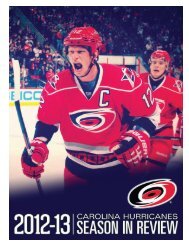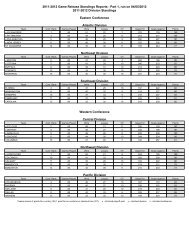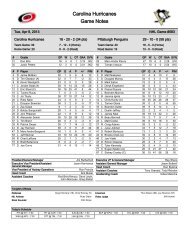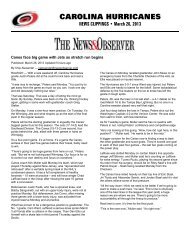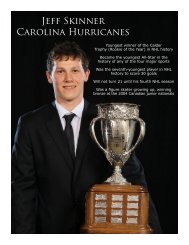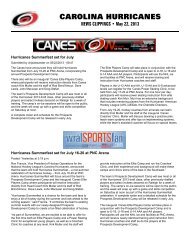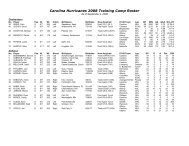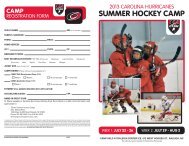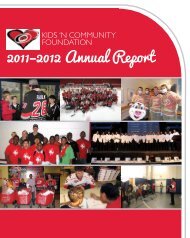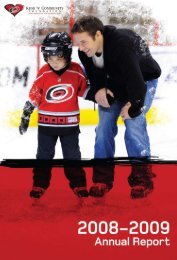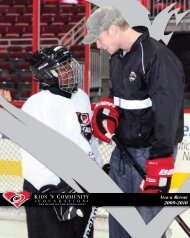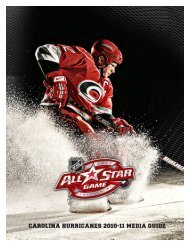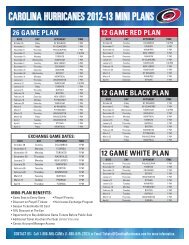2011-12 MEDIA GUIDE - Carolina Hurricanes - NHL.com
2011-12 MEDIA GUIDE - Carolina Hurricanes - NHL.com
2011-12 MEDIA GUIDE - Carolina Hurricanes - NHL.com
You also want an ePaper? Increase the reach of your titles
YUMPU automatically turns print PDFs into web optimized ePapers that Google loves.
HOCKEY OPERATIONS<br />
ORDER Of SELECTION fOR 2010 ENTRy DRAfT<br />
The <strong>NHL</strong>’s annual draft drawing is a weighted lottery system to determine the<br />
order of selection for the first 14 picks of the 20<strong>12</strong> entry draft.<br />
The 14 teams that did not qualify for the Stanley Cup Playoffs, or clubs that acquired<br />
those clubs’ 20<strong>12</strong> first-round draft picks, participate in the drawing.<br />
The Club selected in the drawing may not move up more than four positions in the<br />
draft order, thus only the five Clubs with the fewest regular-season points have the<br />
opportunity to receive the first overall selection.<br />
No Club can move down more than one position as a result of the draft drawing.<br />
in the first round of the 20<strong>12</strong> entry draft, the order of selection is as follows:<br />
a) The first 14 selections, as determined by the draft drawing (see above);<br />
b) Clubs eliminated in the first two rounds of the 20<strong>12</strong> Stanley Cup Playoffs,<br />
regular-season division winners excluded, in inverse order of points;<br />
c) Regular-season division winning clubs eliminated in the first two rounds of the<br />
20<strong>12</strong> Stanley Cup Playoffs, in inverse order of points;<br />
d) Clubs eliminated in the 20<strong>12</strong> Conference Finals, in inverse order of points;<br />
e) Stanley Cup finalist<br />
f) Stanley Cup champion<br />
in the second and subsequent rounds the order of selection is as follows:<br />
a) Non-playoff clubs in inverse order of points;<br />
b) Clubs eliminated in the first two rounds of the 20<strong>12</strong> Stanley Cup Playoffs,<br />
regular-season division winners excluded, in inverse order of points;<br />
c) Regular-season division winning clubs eliminated in the first two rounds of the<br />
20<strong>12</strong> Stanley Cup Playoffs, in inverse order of points;<br />
d) Clubs eliminated in the 20<strong>12</strong> Conference Finals, in inverse order of points;<br />
e) Stanley Cup finalist<br />
f) Stanley Cup champion<br />
ENTRy DRAfT PLAyER ELIgIBILITy<br />
1. Players 18 through 21 years of age when signing their first contract must<br />
remain in the entry-level system for a period of three years; players age 22 and<br />
23 when signing their first contract are in the entry level system for two years;<br />
while those age 24 when signing their first contract are in the entry level system<br />
for one year. age is defined as the player’s age on September 15 of the calendar<br />
year in which he signs the contract, regardless of his actual age on the date he<br />
signs such contract.<br />
2. in the event that a signed 18 or 19-year-old player does not play a minimum of<br />
10 <strong>NHL</strong> games (regular season and/or playoffs) in his first season under contract,<br />
the term of his player contract and his number of years in the entry level system will<br />
be extended for a period of one year. The exception to this is a 19-year-old player<br />
who turns 20 years of age between September 16 and december 31 in his first<br />
contract year.<br />
3. in the event that a player signs his first contract at age 18 and has had his Player<br />
Contract extended for one season already, and such player does not play at least<br />
10 <strong>NHL</strong> games (regular season and/or playoffs) in the second season under that<br />
player’s Player Contract, then the term of his Player Contract and his number of<br />
years in the entry Level System shall be extended for one additional year.<br />
uNSIgNED DRAfT CHOICES<br />
a) a player aged 18 or 19 who was selected in the first three rounds of the entry<br />
draft and who was not signed by his <strong>NHL</strong> Club may not be retained by the Club and<br />
must be returned to his junior Club no later than the day prior to the opening of the<br />
<strong>NHL</strong> regular season.<br />
b) a player aged 18 or 19 who was selected in the fourth or subsequent rounds<br />
who has not been signed by his <strong>NHL</strong> Club may not be retained by his Club and must<br />
be returned to his junior Club no later than the fourth day prior to the opening of the<br />
<strong>NHL</strong> regular season.<br />
260 / <strong>2011</strong>-<strong>12</strong> Media Guide<br />
ENTRy LEvEL PLAyERS<br />
1. Players 18 through 21 years of age when signing their first contract must<br />
remain in the entry-level system for a period of three years; players age 22 and 23<br />
when signing their first contract are in the entry level system for two years; while<br />
those age 24 when signing their first contract are in the entry level system for one<br />
year. age is defined as the player’s age on September 15 of the calendar year in<br />
which he signs the contract, regardless of his actual age on the date he signs such<br />
contract.<br />
2. in the event that a signed 18- or 19-year-old player does not play a minimum of<br />
10 <strong>NHL</strong> games (regular season and/or playoffs) in his first season under contract,<br />
the term of his player contract and his number of years in the entry level system will<br />
be extended for a period of one year. The exception to this is a 19-year-old player<br />
who turns 20 years of age between September 16 and december 31 in his first<br />
contract year.<br />
3. in the event that a player signs his first contract at age 18 and has had his Player<br />
Contract extended for one season already, and such player does not play at least<br />
10 <strong>NHL</strong> games (regular season and/or playoffs) in the second season under that<br />
player’s Player Contract, then the term of his Player Contract and his number of<br />
years in the entry Level System shall be extended for one additional year.<br />
INJuRED RESERvE LIST<br />
in the event that a player is injured and a Club wishes to place him on the injured<br />
Reserve List, the Club must follow these procedures.<br />
1. a Club may place a player on the injured reserve list if such player is injured,<br />
disabled or ill and unable to perform his duties as a hockey player after having passed<br />
the Club’s initial physical examination in that season.<br />
2. a player who has an injury that renders him physically unable to play for a minimum<br />
of seven days after that date of the injury can be placed on the Club’s injured Reserve<br />
List. Once a player is placed on the injured reserve, the Club may replace said player<br />
on its <strong>NHL</strong> roster with another player. all determinations that a player has suffered<br />
an injury warranting injured reserve status must be made by the Club’s medical staff<br />
and in accordance with the Club’s medical standards.<br />
3. a player placed on injured Reserve is ineligible to <strong>com</strong>pete in <strong>NHL</strong> games for a<br />
period of not less than seven days from the date of injury.<br />
4. Players on injured Reserve may attend Club meetings and meals, travel with the<br />
Club and participate in practice sessions.<br />
5. Players on injured Reserve are prohibited from appearing in games, participating in<br />
pre-game warm-ups with their Clubs, or dressing in game uniforms on game days.<br />
REguLAR SEASON wAIvERS<br />
For purposes of Regular Waivers and Re-entry Waivers, the five (5) year exemption<br />
for an 18-year-old skater and the four (4) year exemption for a 19-year-old skater<br />
shall both be reduced to three (3) years <strong>com</strong>mencing the first season that the<br />
18- or 19-year-old skater plays in eleven (11) <strong>NHL</strong> Games or more. The next two (2)<br />
seasons, regardless of whether the skater plays any <strong>NHL</strong> Games in either season,<br />
shall count as the second and third years toward satisfying the exemption. For<br />
purposes of Regular Waivers and Re-entry Waivers, the six (6) year exemption<br />
for an 18-year-old goalie and the five (5) year exemption for a 19-year-old goalie<br />
shall both be reduced to four (4) years <strong>com</strong>mencing the first season that the 18-<br />
or 19-year-old goalie plays in eleven (11) <strong>NHL</strong> Games or more. The next three (3)<br />
seasons, regardless of whether the goalie plays any <strong>NHL</strong> Games in any of those<br />
three (3) seasons, shall count as the next three (3) years toward satisfying the<br />
exemption.<br />
The first season in which a Player who is age 20 or older plays in one (1) or more<br />
Professional Games shall constitute the first year for calculating the number of<br />
years he is exempt from Regular Waivers and Re-entry Waivers.<br />
a Player 25 years old or older who plays in one (1) or more Professional Games in<br />
any season shall be exempt from Regular Waivers and Re-entry Waivers for the<br />
remainder of that season.



